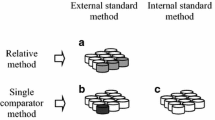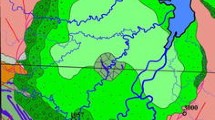Abstract
Neutron activation analysis (NAA) is one of the most used analytical techniques for trace element determination in rocks, because time consuming operations are avoided. We have analyzed different types of USGS reference materials (G-2, GSP-1, BHVO-1, STM-1, GXR-3, GXR-4, GXR-5), using both thermal (TNAA) and epithermal neutrons (ENAA). ENAA has been used to reduce interferences due to Sc-46 and to other high activities. The following elements have shown an improvement when analyzed by ENAA: Ba, Cs, Gd, Rb, Sb, Sr, Ta, Tb, Th, Tm, U, Yb, Zr; better results were found for Ce, Co, Cr, Eu, Fe, Hf, La, Lu, Na, Nd, Sc, Zn with TNAA. The accuracy of both methods has been tested comparing our results with some published values. The agreement is in general very good. The precision also is satisfactory, being for many elements better than 10%. After these tests, a study on some rock samples from the basaltic plateau of Kenya, east of Gregory Rift, has been performed by ENAA. Among the elements determined in this work, the rare earch elements (REE) can give significant petrogenetic information, by means of their distribution and fractionation in the rocks. The main parameters investigated are the degree of fractionation of light (La to Eu) relative to heavy (Gd to Lu) REE and the occurence of Eu anomalies, when the REE concentrations are compared to chondritic values. The evaluation of detection limits by TNAA has been performed for REE in sediment samples from Thyrrenian Sea (Central Italy).
Similar content being viewed by others
References
J. J. ROWE, E. STEINNES, Talanta, 24 (1977) 433.
Z. RANDA, Radiochem. Radioanal. Lett., 24 (1976) 157.
A. A. BRUNFELT, I. ROELANDTS, Talanta, 21 (1974) 513.
G. CAPALDI, P. GASPARINI, A. MOAURO, E. SALVIA, O. TRAVAGLIONE, Earth Planet. Sci. Lett., 17 (1972) 247.
G. H. MORRISON, J. T. GERARD, A. TRAVESI, R. L. CURRIE, S. F. PETERSON, N. M. POTTER, Anal. Chem., 41 (1969) 1633.
M. J. POTTS, T. O. EARLY, A. G. HERRMANN, Z. Anal. Chem., 263 (1973) 97.
F. J. FLANAGAN, Geochim. Cosmochim. Acta, 37 (1973) 1189.
S. ABBEY, Geost. Newsl., 4 (1980) 163.
L. A. CURRIE, Anal. Chem., 40 (1968) 586.
S. J. PARRY, J. Radioanal. Chem., 59 (1980) 423.
F. A. FREY, in: G. K. MUECKE (Ed.) Short Course in Neutron Activation Analysis in the Geoscience, Halifax, 1980.
R. BONIFORTI, private communication.
Author information
Authors and Affiliations
Rights and permissions
About this article
Cite this article
Madaro, M., Moauro, A. Trace element determination in rocks and sediments by neutron activation analysis. Journal of Radioanalytical and Nuclear Chemistry, Articles 114, 337–343 (1987). https://doi.org/10.1007/BF02039808
Received:
Issue Date:
DOI: https://doi.org/10.1007/BF02039808




